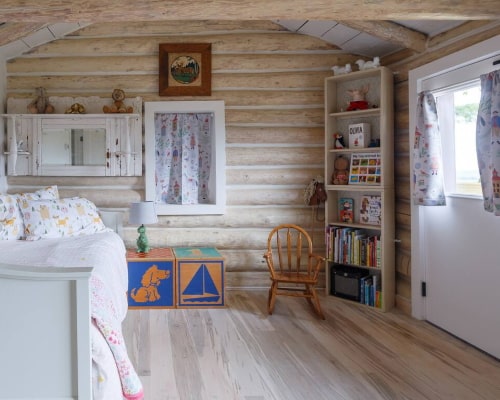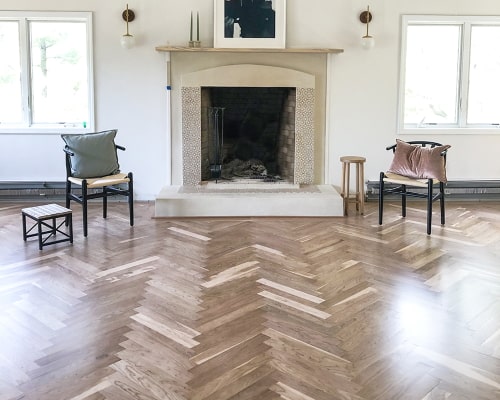Flooring 101: How to Make Your Flooring Fit Your Climate
July 10, 2017
Living in the New York and New England regions comes with the benefit of experiencing a four-season climate. Though undoubtedly beautiful, changing seasons can be accompanied by challenges. Knowing the weather is volatile, most residents of these areas are experts in preparing for the unexpected elements. But how many people consider the change of season when in the market for buying wood floors?
As a manufacturer of flooring for over 15 years, Excelsior knows the benefit of an educated customer. In finding an alarming number of homeowners unaware they should consider climate when designing their flooring, we have outlined some significant reasons as to why they should start. Combining our knowledge of wood, with the professional recommendations of the National Wood Flooring Association (NWFA), here are some important variables to keep in mind when purchasing flooring in a seasonal climate region.
Wood is a ‘Living Product’
This statement may sound a bit creepy, but in all honesty very true! Wood is a natural material with hygroscopic properties, meaning: a substance that absorbs and retains moisture directly from its environment. Unlike human-made materials, wood flooring derives from a living organism that preserves these organic properties, even after being cut down.
After manufacturing into flooring, wood continues to absorb moisture from its new environment causing the ‘expanding and contracting’ phenomena we often hear. When humidity levels are high, wood absorbs the excess moisture in the air expanding as a result. The opposite occurs when the air is dry, causing the wood to contract with a lack of moisture to consume.
Preventing wood from absorbing moisture is little too impossible. But by using techniques to limit or stabilize the moisture level in your environment, your home environment can be prepared to accommodate the natural variability of a wood floor.
Established Internal Climate
Knowing the climate conditions you expect your flooring to survive in is essential upon finding the ideal wood product. Moisture levels in your home will vary based on both internal and external elements. Methods used to heat, cool, and insulate your home, as well as the nature of the room you wish to install the flooring (ex: kitchens vs. bedrooms), can all contribute to a rise and fall of moisture.
It is always wise to be aware of the climate-controlling systems used in your home, as they will directly impact your wood floors’ success in acclimating to its conditions. The functionality of these systems is equally important in establishing a pattern of your home’s seasonal climate. The National Wood Flooring Association (2007) suggests:
“If heating and/or air-conditioning is in operating condition, it needs to be operating. If it is not possible for the permanent heating and/or air-conditioning system to be operating before, during and after installation, a temporary heating and /or dehumidification system that mimics normal temperature and humidity conditions can enable the installation to proceed until the permeant heating and/or air-conditioning system is operating,” (Section I, p. 1).
If you are in the midst of new construction and not sure what systems you will be using, waiting till these systems are active before finalizing an internal climate is the best practice, but not always practical. Using devices such as dehumidifiers, portable heating/cooling systems, and moisture meters to measure progress, the National Wood Flooring Association (2007) highlights a variety of tips of the trade to keep your project schedule flowing (Section I, p. 1-7).
Quality Grade Materials
You hear time and again, ‘quality over quantity’; we are not going to suggest anything less. A growing number of homeowners are opting for bargain wood flooring from warehouse sales and box stores. With the promise of high quality at a low cost, these materials tend to fit smoothly into a tight renovation budget. But not all wood flooring is created equally or manufactured with the same care.
Often, the low-cost floors are made of sub-quality materials, sometimes of unknown composition or undesired grades of common species. Though these products are classified as solid wood, their performance does not compare to legitimate solid wood products. Some pre-finished options have even recently been reported to contain harmful chemicals, resulting in an uproar of possible health concerns from installing cheap flooring.
Excelsior only mills solid wood flooring of quality grades from reputable suppliers. We customize flooring to your particular space, keeping in mind your budget, lifestyle need, and aesthetic design. Our products are manufactured using materials and coatings safe for your home, with specific maintenance instructions provided to extend the life of your flooring. Excelsior has an open door policy allowing for customers to reach out with any ongoing questions they might have on their orders; benefits not comparable to just a bargain price.
Flooring Acclimation
In our industry, the majority of customers have time-sensitive projects. When on a strict schedule, some are tempted to consider the acclimation process as more of an option rather than a necessity. However, those who skip this step pose the risk of unintended defects in the flooring due to increased movement after installation.
Acclimation is the process by which the wood becomes accustomed to a new environment. By allowing your material time to adjust to the moisture level of your space, individual pieces will expand and contract prior to installation to decrease the chance of gaps and cracks.
The National Wood Flooring Association (2007) suggests always follow specific manufacturers’ recommendations for acclimating your wood flooring to your environment, as every species and style will behave differently when exposed to moisture. Standard practices for multiple wood floorings include (Section I, p. 5-6):
- Installing flooring last in a home improvement project.
- Establishing the internal climate of your home.
- Operating heating/cooling systems five days prior to installation.
- Checking material upon delivery for moisture level with a meter.
- Comparing the moisture level with the subflooring.
Acclimating your wood flooring may sound quite technical, but it doesn’t have to be difficult. Using recommendations from the NWFA, communicate with your subcontractors on what information is still needed to make sure the acclimation process is successful. If you need to reach out for specific details on your flooring, Excelsior product specialists would be happy to help! Discussing the procedures for acclimation with your subcontractor will help to ease your mind prior to the grand finale; installation day.
Proper Installation
Perhaps the climax of any project is the excitement of seeing newly installed flooring in your home. However, nightmare installations do occur, and most of the times they can be prevented. If you have taken all of the above suggestions into consideration (climate, quality wood, acclimation) you have most of your bases covered, but not all!
Prior to the actual date you wish to install your flooring, it’s important to establish a step-by-step installation plan. If you are subcontracting the service out, finding the best installation assistance for the job is the first step in ensuring your material is properly installed. Requesting referrals from trustworthy sources, or using online search engines geared towards marketing well-known vendors, is a valid place to begin your hunt for the best subcontractor for your project.
Knowledge of your product and popular install methods for your material can also be essential tools in ensuring a smooth installation process. The National Wood Flooring Association (2007) dives deep into installation practices specific to various styles of flooring: parquet, engineered, solid strip and plank, and installations over existing flooring (Section III, p. 1-15). All floors are different, as every home is unique. A quick scan of general suggestions or just any friend’s advice will not do the job for gaining the proper knowledge of your product. Always do your research and refer to the professionals suited for your specific project when planning for install of any wood flooring.
Knowledge Over Chance
If there are variables you or your subcontractor are unsure of during any step of the flooring process, wait. Don’t take a chance on a product that may not be suitable for your environment. The last characteristic you want to see on your new flooring is unintended cracking and large gaps resulting from a rush decision.
Sometimes our wish for an authentic ‘wood look’ can be greater than our will to accept that our climate may not accommodate the material. For instance, houses built over running water may never have the ability to control moisture enough for a wood floor to set properly. The key to any successful flooring purchase is communication with the right professionals and complete transparency about the climate of your home.
At Excelsior, our service is as organic as our materials; we care about how our products affect our customers. In a fast-paced industry, knowledge and patience are still fundamentals in our business. Nature is unpredictable, climates vary, but with a little time, Excelsior will guide you through the variables you can control to create a final product you will love.
Get a quote on flooring today!
References:
National Wood Flooring Association. (2007). Installation Guidelines. Section 1: General
Guidelines. Retrieved from NWFA-Installation-Guidelines



